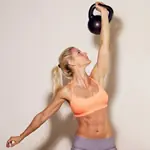Just Because You Can Doesn't Mean You Should
Stone told me the first thing people ask him when he espouses the sweet science of honey is, "What about electrolytes?"
The answer is that depending on the conditions and your nutritional balance, you don't need that many.
"The body has its own remarkable system of checks and balances," he said. "Let it do its thing."
Stone added that every time you add dissolved electrolytes to pure water, you're slowing down the gastric intake process.
The simpler you keep carbohydrate supplementation, the easier it is for your body to process the fuel. So while you may swear by eating a gel every 45 minutes and you're not suffering gastric distress, that doesn't necessarily mean you should maintain that strategy.
In Henderson, I literally didn't consume an ounce of actual food besides honey, water and electrolyte drink. I never felt hungry, and while I did feel somewhat bloated on the first half of the run (Stone and registered dietician Katie Rhodes think I should pour a half-ounce less of honey in each gel flask container), I ran a personal-best on a hilly, humid course. That's two consecutive Ironman 70.3 events achieving two of my best Ironman 70.3 runs, both following the honey-water plan. Obviously, Stone was not surprised.
"When people get hungry that's psychosomatic," he said. "Some people need (nutrition) with more texture and mouth-feel to be happy. If they can just get over that craving, they're still getting 60 grams of carbohydrate per hour. I promise they're going to be happier."
More: 4 Ways to Save Your Legs for the Triathlon Run
Timing is Everything
Honey may be the best natural endurance nutrition source, but it's not without some risk. Stone advises clients to take a sip of honey water between every 8 to 10 minutes on the bike and approximately every 15 minutes during a run, and that's only after the first hour of activity.
Your natural glycogen stores, further powered by a well-timed pre-race meal, can handle the first hour. That's where trusting your body comes into play. Consuming too much pure glucose and fructose can cause severe cramping and even vomiting.
Stone notes that trying to catch up on missed honey water intervals with more sips can be just as harmful. Keeping a consistent regimen is key. I've used my Garmin watch to set regular intervals for both bike and run courses.
So why don't more people flock to Stone's approach? Stone thinks there are two reasons. First, people are apprehensive to try something that doesn't seem "normal." The idea of eating less while still consuming the necessary calories and carbohydrate to complete an endurance event appears counterintuitive.
Second, the current training paradigm is that carbohydrate is needed in bulk, thanks to single-use gel packets that require the user to down all the contents at once.
"The only reason you take that (gel) pack all at once is that you can't reseal it, which is why maltodextrin is a key ingredient," Stone said. "But that gel doesn't break down as purely as straight glucose or fructose."
More: Avoid a Race-Day Nutrition Disaster
 Search for your next triathlon.
Search for your next triathlon.
- 2
- of
- 2









Discuss This Article